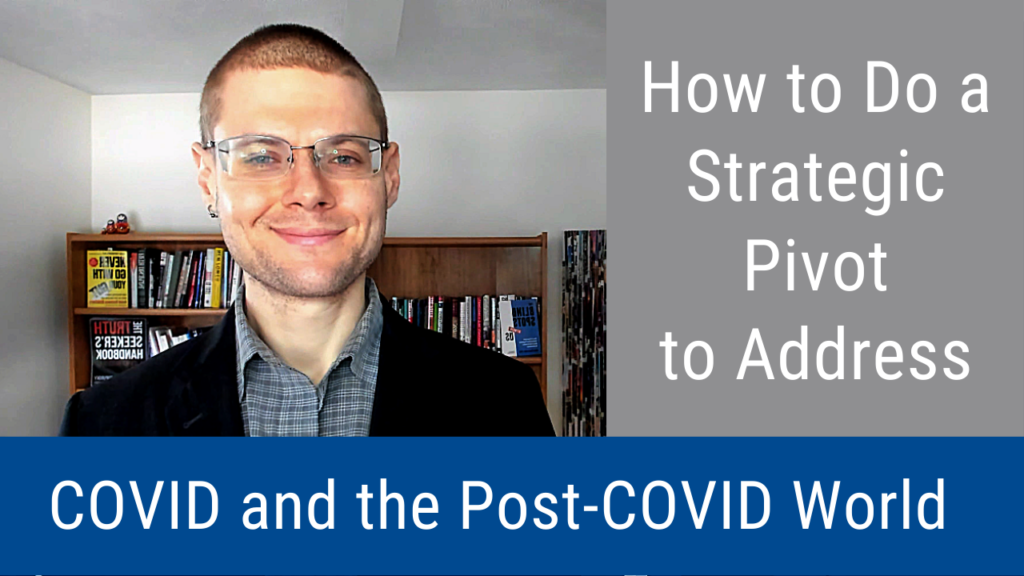
A strategic pivot will enable your company to survive and thrive during the COVID pandemic and in the post-COVID world. Start by challenging assumptions about your internal and external business model. Then, revise your strategy and determine next steps to operationalize these changes. That’s the key take-away message of this episode of the Wise Decision Maker Show, which describes how to do a strategic pivot to address COVID and the post-COVID world.
Video: “How to Do a Strategic Pivot to Address COVID and the Post-COVID World”
Podcast: “How to Do a Strategic Pivot to Address COVID and the Post-COVID World”
Links Mentioned in Videocast and Podcast
- Here’s the article on How to Do a Strategic Pivot to Address COVID and the Post-COVID World
- The book Resilience: Adapt and Plan for the New Abnormal of the COVID-19 Coronavirus Pandemic is available here
- You are welcome to register for the free Wise Decision Maker Course
Transcript
Hello, everyone, and welcome to another episode of the wise decision maker show where we help you make the wisest and most profitable decisions. Now today I want to talk about how to do an effective strategic vote to address COVID. And the post COVID recovery COVID will be around for many more months, we have the new strains that are going to be a serious problem with both their increased infectiousness and especially the problem of some of the newer strains, the South African one, the Brazil one similar ones, with some vaccine immunity, that they are somewhat vaccine resistant. So they’ll still be around for a while that we’ll have to deal with COVID itself. And we also have the process of post COVID recovery as COVID becomes less powerful, less prevalent. After we have widespread vaccination, we will still be dealing with recovery where again, some vaccine resistant strains will still be causing some outbreaks, they’ll still be problems. So that’s going to be a post called, that’s going to be a recovery after COVID slowly gradually transitions from being a pandemic into being what’s called an endemic disease, meaning just present just like the flu that is present. And there is going to be so post COVID recovery, there will be a complex, ambiguous, uncertain transition, and there’s going to be an economic recovery. So that will be part of the post COVID recovery that you want to be thinking about. So that’s going to be a couple of years of many, many months, many months of COVID, then a couple of years of the post COVID recovery, and then living in a post COVID world which will be very different in many ways than the world before COVID. So that’s something that you want to be thinking about the world after COVID will also be quite different. And so you want to strategically pivot for that you want to pivot your organization to not simply survive, but thrive through many months of COVID through the post COVID recovery, transitioning gradually, slowly ambiguously from a pandemic into an endemic disease, and then the post COVID world itself. And that strategic pivot is something that you really need to be working on effectively, the first step to working on your strategic pivot is to get buy in from the leadership team. So you as a member of the leadership team, however, whatever your role is, you need to get buy in from members of the leadership team itself on doing an effective strategic pivot. Now, in order to get their buying, you need to convince them of the need for a strategic pivot, just like we talked about earlier, about COVID being around for many months recovery, how to be complex, uncertain, ambiguous, gradual couple of years. And the fact that we’ll never go back to pre COVID reality, I mean, work from home, for example, will still be around to a much, much, much greater extent, after the whole post cover recovery several years from now, way much more work from home than before COVID. And virtual meetings will be much more present. Personally, people will be meeting much more virtually, because it saves time. It’s more efficient, it’s more effective than in person meetings, and many other things. And just these virtual things are just a couple of dynamics I wanted to highlight. So you need to adapt, and you need to convince your leadership team that they need to adapt to a post COVID world in the long term. And that is part of the strategic pivot to buying. Once you get buying, as you’re working on the strategic pivot itself, the first step is to challenge your business model assumptions that challenge those business model assumptions, which I see the large majority of organizations functioning with their business model assumptions. They’re just changing things on a day to day basis. They’re not changing them strategically. They’re looking at operations. And okay, when COVID treating this as an emergency, let’s deal with day to day stuff. They’re not taking a strategic look at how to transition their operations for not simply many months of COVID, but the couple of years of the post COVID recovery and the post COVID world. So what you want to do is explore the problems and opportunities that you have had recently. Both problems and opportunities don’t want to simply deal with problems, there are a number of opportunities that you can pursue in this environment. And you want to see which of these opportunities have external ones, the internal ones and which of these problems again, external ones and internal ones will still be around. I mean, there are some that are one time things, but there’s some that will still be around in the show. term of the COVID itself. So the many months of COVID, that’s going to be something you want to think about, you know, short dish term, let’s use the phraseology, short term, many months of COVID, you know, let’s say through the end of 2021, then continuing for the post COVID recovery, let’s say a couple of years after that, you know, fruit 2023. And how many of them will remain in the post COVID world in the foreseeable future, let’s say, you know, give us the timeline horizon of until 25, low until then five year horizon for 2025. So that’s easily predictable, you might have what you might be thinking about for, let’s say, 2030 is another way that you can be thinking about which ones have the motivation, it’s hard to predict more than five years out. But you know, you can try predicting 10 years out, but it’s definitely gonna be very, very hard for you to predict more than 10 years out. So thinking about that pulse COVID world, it’s a good orientation to look at the five years from now, no more than 10 as a challenge business model assumption, so you have that discussion with the leadership team challenging business model assumptions. So that’s kind of the first step of the strategic pivot after getting there by and then after the challenge business model assumptions. You go back, each of your leadership team members goes back to gather internal information from their direct reports. So the leadership team goes to their direct reports and gets feedback from them. So it’s not simply You know, one than done with a challenge business model assumptions, you get feedback from your direct reports on the outcomes of the discussion on challenging business model assumptions, share with them the outcomes, you know, what happened, what are you thinking about challenging those assumptions, and get their feedback so that you get information from the organization itself, that’s really helpful. And your direct reports should of course, talk to about these topics, to their stakeholders, whether it’s, whether it’s clients, whether it’s vendors, whether it’s investors, your team members may be dealing leadership, team members will maybe they’re dealing directly with investors, all sorts of folks like this to get feedback from them on these issues. So specifically, you want feedback on how to pivot for many months of COVID, that short term for 2021. gradual and complex recovery. So giving it a couple of years for 2023 doesn’t mean that it will be for 20 to 23. But just the many months of COVID is the crucial thing, and not in 2021. But you want to be thinking about Okay, maybe that will be around that thinking on average, then gradual and complex recovery might be for 2023, but it might be shorter or more likely longer. And then the changing post COVID world is more easily predictable for 2025. You know, it’s harder to do so but you know, you can try to make it last for 20 to 30. So gather internal information, then you want to have a full strategic retreat, a two day strategic retreat. So two full days after we gathered the information for your leadership team, so two full days of your strategic retreat. First day is devoted to strategy. So it’s the first day, the first day you want to do a strategic shift for the monuments of COVID. than the gradual complex recovery and the post COVID world, you might want to make sure to face head on difficult issues. I’ve done this strategic retreat for over 10 companies already. And it’s very tempting to not face head on the difficult issues that you have to deal with weather issues like how to change your culture from people still have essentially an office culture of transposed on remote work to actually culture optimized to remote work to having let’s say, your customers that you still targeting the right customers, if you are thinking about many months of COVID, both COVID recovery, and that new world after COVID and many other things, channel orient toward the long term goal. So you want to really be thinking about what’s going to be going on in the long term, said the end of 2025. In the long term, you can try setting 2030. But let’s say you said 2025, but post COVID world that’s going to be your long term goal. What do you want your company to look like, paint a narrative and paint a story? What do you want your organization to look like? What does it look like at the end of 2025? So you want a clear narrative of vision, essentially, that is what you want. So paint a vision, a narrative of those long term goals that you want to see a company that plays in the post COVID world in the end of 2025 or if you want to be a little bit more ambitious and In a situation that’s more ambiguous, uncertain, and of 2030, what does your company look like, at that time? So paint that clear narrative, paint that clear vision and of 2025 and of 20 2030 and up to 2030. That really the world after COVID and what it looks like for your organization. So look at those outcomes, think about, what is it? What is your organization like? How is it different than it is right now? Then what backward to the current day? So what backward from the end of 2025, or end of 2030? backward to the current day? So, we’ll: What does it take to get there? What does it mean to get to that vision? What kind of steps do you need to take, and of course, make sure to address the complex recovery. So which will be going on, let’s say, approximately, from end of 2021, two end of 2023, and the many months of COVID, which will be approximately going on through end of 2021, depending on the situation where the vaccine hesitancy and vaccine resistance strains and new strains and things like this. So that’s the first day of the strategic retreat. And that’s devoted to your strategy more broadly, the second day will be devoted to operationalizing your strategy, so implementation, thinking about how do you implement these things, you want to decide on changes that you need to survive and thrive for many months of COVID, for the complex, ambiguous post COVID recovery. And in the post COVID world for 2025, let’s say, or 2030, see one, decide on the changes that you need to achieve these goals in your internal structure in your internal culture. So those are two different things, your internal structure, organizational structure, staffing, and so on your internal culture policies, norms, behaviors, how you interact with each other, then your external partnerships, then, of course, it’s going to be your clients, your vendors, your investors. So thinking about all of those sorts of things, your community stakeholders, perhaps political leaders, depending on how you’re engaging with them. And then think about your budget, your finances, how do you need to address that? Where do you need to redirect restricted, if you’re going to be serious, which you really should be about having people work from home effectively, doing things like providing them with money for working from home environments, and various other tools, many things like this, then your staffing, how they need to change your staffing for that long term orientation and the 2025 end of 2030. With that transition, the many months of COVID boss COVID recovering, and any new initiatives, you very likely have to take a number of new strategic initiatives for that situation to be brought into place effectively. Then, you want to look for another part of that operationalization once you make a decision, these major changes are to explore how various future scenarios might impact these changes. So what are the future scenarios and future scenarios with COVID? There might be more optimistic scenarios with the new strains, vaccine resistance, vaccine uptake, and less optimistic one. So you want to explore that. You want to explore things like various economic outcomes with the recovery, some recovery might be longer and more problematic. It might be shorter, various situations like government initiatives that might impact did various things in your market that might impact it. So think about the broader context. And then think about your specific context of your industry. And of course, your specific company, what are the potential threats and opportunities that might be present in all of those scenarios. So think about the threats and opportunities in a variety of scenarios, both in the broader context, and more specifically in your industry. And then more specifically for your company, depending on what’s going on in your company in your organization. What are the potential threats and opportunities in all of these scenarios, and make plans to avoid the more dangerous threats, so make plans that would cause you to avoid these threats or address them effectively, if they do arise? Some of them you can avoid right now by taking steps to prevent them from happening. So for example, you can decrease work from home burnout that is going to harming retention, productivity, lowering brow, various lowering worsening health other issues, and you want to make steps to avoid missing opportunities. So a lot of those scenarios will have opportunities that you can take advantage of or you can miss out on depending on whether you take steps right now to prepare for them. Some of them you can take steps to bring about right now. And some of them you can just make a plan to seize if they do occur. So you want to develop roadmaps after doing all of that. So you do that to address threats, murky opportunities. And then the next step to operationalizing. It is developing specific roadmaps for yourself or your company, for your organization, for your leadership team, for communication on this end for operational changes, how will you communicate about the strategic shifts, and the operation shifts to your team members? So communication, and that’s going to be part of the component part of what we’re talking about here. And the other part is, how will you implement operational changes? So that’s what you want to be thinking about implementation of your communication strategy and implementation of your operations changes. Then I’ll do another part of the second day, operations day is deciding on the next steps. What are the actual specific next steps you will do? You talked about and broadly, the upgrade strategy for communicating and operationalizing it, but you want to get specific and talk about the specific next steps that will happen as a result. So determine the next steps and the terms and decide on what resources will be required for these next steps. You don’t need to decide, you know, all the next steps because they’re somewhat ambiguous, but you want to determine the immediate next steps. And more broadly, you want to decide on the resources required for not simply the immediate next steps, but more broadly, the steps for implementing communication for all of these sorts of things. For each of the steps that you take, identify success metrics, what does success look like for each step? What does it mean for you to accomplish the steps for your organization to accomplish that step, then which team members and leadership team members will be involved in each step? So if it’s sales, you know, it’s going to be sales, marketing, maybe your operations team things like this, your budget, obviously, the CFO will lead it and have a couple of folks involved. So one, team members will be accountable for the step, if it’s a deciding to shift your target your target market to expand another category, you might put your marketing person in charge of that, because you want to enter new markets, you’ll need to market and of course, sales team members need to be as the sales team leader needs to be on the team, not necessarily leading it, depending on the structure in your company, marketing would probably be leading it but you could have sales leading it to depending on how you operationalize things. And the operations person would want to be on top of it, maybe r&d, your research person, depending on the kind of organization you’re in. And then you want to prepare a report on the strategic pivot for your board of directors. Of course, that’s a major thing, patriot initiative, major changes. So talk to your board of directors and prepare a report on the strategic pivot to the Board of Directors, then how will you follow up? How will you follow up to make sure that this strategic pivot is implemented and actually effectively achieves its goals? I would recommend following up in whatever forums you currently have. You have weekly team leadership meetings, follow up on that if you have something like bi monthly ones follow up on that if you have one on ones of various sort, follow up on that most organizations have weekly leadership team meetings. So I would recommend that you have to follow up with each team member accountable for next steps describing what they’re doing for the next steps. And then I recommend that you at certain points, do a half day event, not a full two day event which you did for the strategic pivot itself, but a half day event where you assess how well the strategic pivot went. And you update the strategy or the implementation of the strategy because you know, you don’t know what you don’t know right now, you don’t know how well the strategy will go. So you want to have half day events where you have time for your leadership team to discuss and assess the strategic pivot all aspects of it, and update the strategy as needed, or update some implementation as needed. What I recommend you schedule it for is one month. So after a strategic pivots strategic retreat itself, then in a month, you want to have David to address set, assess the strategic pivot of the day the strategy or the implementation, then you want another one three months after the original strategic retreat, and then another one six months after the original strategic retreat for the strategic pivot. So that would be my recommendation for how based on helping lead over 10 companies in strategic pivots how you would do an effective strategic pivot to address COVID, the remaining months of COVID and then the post COVID transition and the reality of the post COVID world. Alright, everyone, I hope you’ve enjoyed this episode of the wise decision maker show Please subscribe to us follow us and whatever channel you’ve gotten this videocast from or this podcast from. We do have both a video and a podcast format audio format. So you both are going to be in the show notes. And, again, follow us, subscribe to us. And please click like to indicate that you’ve enjoyed this content and leave your review. Leave your comment to show us what you think of it on iTunes elsewhere, wherever you’re getting it. It’s really helpful for us to have your comments because it helps us provide much better content for you. There’s going to be a blog in the show notes with much more information about this topic. So check that out as well. Alright everyone, I hope you’ve benefited from this episode of the wise decision maker show. And as always, until next time, I wish you the wisest and most profitable decisions, my friends
Transcribed by https://otter.ai
Originally Published at Disaster Avoidance Experts on March 9, 2021




